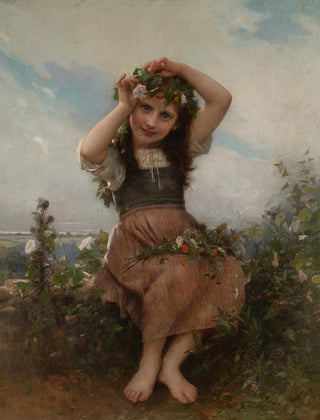Art print | A crown of wildflowers - Léon Jean-Basile Perrault Source: Reproduction | Une couronne de fleurs sauvages - Léon Jean-Basile Perrault


View from behind

Frame (optional)
In the enchanting world of floral art, the "Une couronne de fleurs sauvages" art print by Léon Jean-Basile Perrault stands out for its delicacy and poetry. This painting, which evokes the fleeting beauty of flowers, transports us to a secret garden where nature expresses itself with infinite grace. Perrault, a French painter of the 19th century, manages to capture the very essence of wild flora, revealing a sensitivity that is both personal and universal. Through this work, he invites us to contemplate the splendor of natural elements while offering a reflection on the passage of time and the fragility of life.
Style and uniqueness of the work
The piece is characterized by a vibrant color palette, where shades of green, yellow, and violet intertwine harmoniously. Each flower seems to come alive, as if the artist's brush had captured the delicate movement of a petal caressed by the wind. The composition, both rich and balanced, evokes a crown, a symbol of celebration and beauty. Perrault excels in rendering textures, providing a sense of depth that invites the viewer to come closer. Light plays a crucial role in this art print, illuminating the flowers with an almost divine glow, while the delicately placed shadows add a dimension of mystery and dream. This unique style reflects a true love for nature, while revealing the artist's technical mastery.
The artist and his influence
Léon Jean-Basile Perrault, born in 1832, is often associated with the naturalist movement that marked his era. Trained at the École des Beaux-Arts in Paris, he absorbed influences from the great masters of floral painting, while developing a style that is uniquely his own. His work is marked by a quest for truth and beauty, seeking to establish a dialogue between man and nature. Perrault succeeded in establishing himself in the art world through his faithful and poetic representations of flowers, but also through his commitment to the preservation of nature. His influence endures today,

Matte finish

View from behind

Frame (optional)
In the enchanting world of floral art, the "Une couronne de fleurs sauvages" art print by Léon Jean-Basile Perrault stands out for its delicacy and poetry. This painting, which evokes the fleeting beauty of flowers, transports us to a secret garden where nature expresses itself with infinite grace. Perrault, a French painter of the 19th century, manages to capture the very essence of wild flora, revealing a sensitivity that is both personal and universal. Through this work, he invites us to contemplate the splendor of natural elements while offering a reflection on the passage of time and the fragility of life.
Style and uniqueness of the work
The piece is characterized by a vibrant color palette, where shades of green, yellow, and violet intertwine harmoniously. Each flower seems to come alive, as if the artist's brush had captured the delicate movement of a petal caressed by the wind. The composition, both rich and balanced, evokes a crown, a symbol of celebration and beauty. Perrault excels in rendering textures, providing a sense of depth that invites the viewer to come closer. Light plays a crucial role in this art print, illuminating the flowers with an almost divine glow, while the delicately placed shadows add a dimension of mystery and dream. This unique style reflects a true love for nature, while revealing the artist's technical mastery.
The artist and his influence
Léon Jean-Basile Perrault, born in 1832, is often associated with the naturalist movement that marked his era. Trained at the École des Beaux-Arts in Paris, he absorbed influences from the great masters of floral painting, while developing a style that is uniquely his own. His work is marked by a quest for truth and beauty, seeking to establish a dialogue between man and nature. Perrault succeeded in establishing himself in the art world through his faithful and poetic representations of flowers, but also through his commitment to the preservation of nature. His influence endures today,






